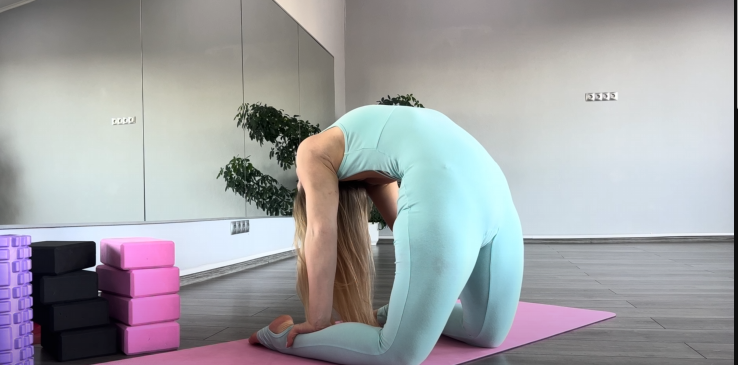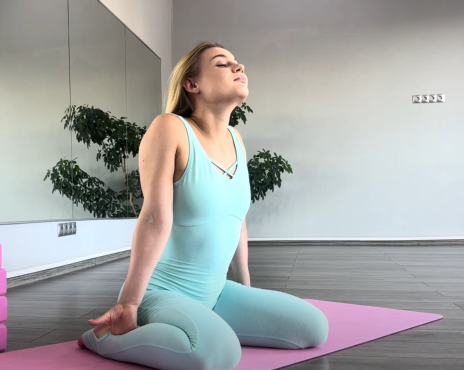
If there’s one movement that screams strength, control, and flexibility, it’s the middle split. It’s more than just a fancy pose or an impressive party trick — it’s a complete lower-body transformation tool. Whether you’re a dancer, martial artist, yogi, or fitness enthusiast, mastering the middle splits can unlock a whole new level of mobility, balance, and leg strength.
But what most people don’t realize is this: doing the splits isn’t about being “naturally flexible.” It’s about training your body smart, consistently, and with intention. Once you understand the mechanics behind the middle split and how to safely progress toward it, you’ll be surprised how fast your legs become stronger, more open, and more powerful than ever before.
Let’s dive deep into how the middle splits can become your game-changing flexibility hack — and how you can start building strong legs, fast!
💡 What Are the Middle Splits, Really?
The middle split (also known as the straddle split) involves spreading both legs wide apart to form a straight line across the floor, ideally with your hips, knees, and ankles aligned in one plane.
It primarily stretches and strengthens:
- Inner thighs (adductors)
- Hamstrings
- Hip flexors
- Glutes and core stabilizers
But here’s the secret: doing middle splits isn’t only about flexibility — it’s about active control. When you train for middle splits correctly, you’re teaching your muscles to stay strong even when lengthened. That’s what gives you the sleek, powerful, and injury-resistant legs that dancers and athletes are known for.
🧠 The Science Behind Middle Split Training

Think of your muscles as elastic bands. If you suddenly pull them too far without control, they resist — or worse, tear. But if you gradually train them through a combination of dynamic movement, deep stretching, and active engagement, the muscle fibers adapt. They lengthen and strengthen at the same time.
This process, called loaded stretching, builds real flexibility — the kind that lasts.
When you apply this method to middle split training, your body doesn’t just “loosen up.” It learns to move through a greater range of motion with power.
That’s why people who commit to split training often notice:
- Their squats get deeper
- Their kicks get higher
- Their posture improves
- Their joints feel lighter and more mobile
⚡ The Benefits of Training for Middle Splits
You might think middle splits are just for dancers or gymnasts, but the benefits go far beyond aesthetics. Here’s what consistent training can do:
- Explosive Leg Power
By strengthening your adductors and glutes through full range motion, your jumps, kicks, and sprints become more powerful. - Better Mobility & Joint Health
Stretching the hips, hamstrings, and inner thighs enhances blood flow, lubricates joints, and prevents stiffness from sitting too long. - Injury Prevention
A flexible yet stable lower body is far less prone to strains, tears, or imbalances. - Improved Balance and Coordination
Working both legs equally teaches your body symmetry — a key to athletic precision and fluid movement. - Grace, Posture, and Body Awareness
The more control you have in deep stretches, the more elegance and ease you develop in daily movement. - Confidence Boost
Let’s be honest — nailing your first middle split feels amazing. It’s a powerful reminder that persistence pays off.
🧘♀️ Step-by-Step: Training Smart for Middle Splits

Here’s a progressive system to move safely toward your middle split goal.
1. Warm-Up (5–10 minutes)
Never stretch cold muscles! Start with light cardio or mobility drills to increase body temperature.
Examples:
- Jumping jacks or light jogging
- Hip circles
- Leg swings (forward/backward and side-to-side)
- Squats or lunges
Your goal is to get your hips and hamstrings warm and ready to stretch.
2. Dynamic Stretches (5–7 minutes)
Before you sink into deep stretches, move your joints dynamically.
Try this mini routine:
- Side lunges (Cossack squats) – 10 reps each side
- Butterfly pulses – 20 reps
- Seated straddle reach (side to side) – 10 reps
- Standing leg swings – 10 reps each leg
These movements activate the inner thighs and hips without forcing them into deep tension.
3. Deep Stretches (10–15 minutes)
Now that your muscles are primed, it’s time to deepen the work.
A. Pancake Stretch
Sit with legs apart, toes up, and slowly walk your hands forward, keeping your spine straight.
Hold for 60 seconds, breathe deeply, and gently go deeper with each exhale.
B. Frog Pose
From hands and knees, slide your knees apart and your feet outward, keeping ankles in line with knees.
Hold for 1–2 minutes. Keep the hips in line with your knees — don’t drop the belly.
C. Standing Straddle Stretch
Stand with legs wide, hinge at the hips, and place your hands on the floor.
Hold 45–60 seconds, relaxing into the stretch without bouncing.
D. Wall-Assisted Split
Lie on your back near a wall, raise your legs, and slowly let them slide apart, using gravity.
Hold for 2 minutes, focusing on slow breathing.
4. Strength-Building for Flexibility (10 minutes)
Flexibility without strength leads to instability. Build control with these exercises:
- Active Leg Lifts (Straddle Position) – Sit in a wide “V”, lift one leg up and hold for 2 seconds. 10 reps per leg.
- Isometric Holds in Frog Pose – Press your knees into the floor as if resisting the stretch for 10 seconds, then relax. Repeat 3 times.
- Cossack Squats – 10 reps each side, slow and controlled.
- Glute Bridges – Strengthens posterior chain for hip balance.
5. Attempt the Middle Split (Safely!)
Now, it’s time to gently explore your current range.
Start from a standing straddle and slowly slide your feet apart. Support yourself with your hands or yoga blocks.
Stop before pain — discomfort is okay, sharp pain is not.
Hold for 30–60 seconds, then ease out carefully.
Progress comes from consistency, not forcing. Doing this 3–4 times a week will yield faster, safer results than pushing too hard once.
⏳ The Timeline of Progress

Every body is different. Some people achieve their splits in a few weeks; others need months. What matters is staying patient and consistent.
Average progress timeline:
- Week 1–2: Looser hips, better posture
- Week 3–4: Noticeable depth improvement in straddle and lunges
- Week 5–8: Comfortable 90% split position
- After 2–3 months: Full split or near-perfect alignment
Remember — your flexibility journey is not a competition. Listen to your body, celebrate every inch of progress, and honor the process.
🌈 Pro Tips for Faster Results
- Consistency beats intensity. Short daily sessions (15–20 minutes) are better than one long weekly session.
- Breathe deeply. Exhaling during each stretch helps release tension.
- Stay hydrated. Muscles stretch better when your body is hydrated.
- Include rest days. Recovery allows muscle fibers to repair and adapt.
- Visualize success. Imagine your hips melting closer to the ground — visualization activates real muscular responses!
💪 Middle Splits = Functional Strength
When you master the middle splits, you don’t just gain flexibility — you transform your functional movement.
You’ll notice it everywhere:
- Your legs feel lighter and faster.
- Your hips open with ease in yoga or martial arts.
- Your core stabilizes naturally in every movement.
The middle split isn’t about pain or pushing your limits recklessly. It’s about discovering the perfect balance between strength and surrender — training your body to be powerful yet fluid, controlled yet free.
🌟 Final Words
The middle split is more than a stretch — it’s a discipline. It teaches patience, focus, and respect for your body’s limits. Every time you train, you’re not just opening your hips; you’re building resilience, self-control, and body awareness.
And when the day finally comes — when your thighs touch the floor and you look up with that rush of pride — you’ll know it was all worth it.
Because the middle split isn’t just a pose. It’s proof that you can achieve anything with consistent effort, mindful practice, and belief in yourself.
So unroll your mat, take a deep breath, and start today. Your game-changing flexibility hack awaits. 💥🧘♀️✨


